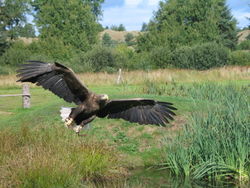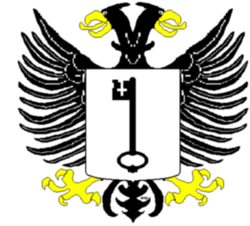|
| Eagle | ||||||||||
|---|---|---|---|---|---|---|---|---|---|---|

White-tailed Eagle in flight
|
||||||||||
| Scientific classification | ||||||||||
|
||||||||||
| Several, see below. |
Eagles are large birds of prey which inhabit mainly the Old World, with only two species (Bald Eagle and Golden Eagle) commonly found in North America, a few in South America, the (White-bellied Sea Eagle, Wedge-tailed Eagle) in Australia and the Philippine Eagle in the Philippine Archipelago. They are members of the bird order Falconiformes (or Accipitriformes, according to alternative classification schemes), family Accipitridae and belong to several genera which are not necessarily closely related to each other.
Eagles are differentiated from other broad-winged birds of prey mainly by their larger size, more powerful build, and heavier head and bill. Even the smallest eagles, like the Booted Eagle, which is comparable in size to a Common Buzzard or Red-tailed Hawk has relatively longer and more evenly broad wings, and more direct, faster flight. Most eagles are larger than any other raptors apart from the vultures.
In Britain before 1678, Eagle referred specifically to the Golden Eagle, the other native species, the White-tailed Eagle, being known as the Erne. The modern name "Golden Eagle" for Aquila chrysaetos was introduced by the naturalist John Ray.
Like all birds of prey, eagles have very large powerful hooked beaks for tearing flesh from their prey, strong legs, and powerful talons. They also have extremely keen eyesight to enable them to spot potential prey from a very long distance. This keen eyesight is primarily contributed by their extremely large pupils which cause minimal diffraction (spreading) of the incoming light.
Eagles build their nest in tall trees or on high cliffs. Their nests, which are sometimes called eyries, can grow to 10 feet in diameter and weigh as much as 2000 pounds.
Eagles are sometimes used in falconry. They appear prominently in myth and literature. In the Old World, such references are commonly to the Golden Eagle (or possibly closely related species found in warm climates).

Taxonomy
For many years there has been some scientific debate as to whether the Accipitriformes are a separate order, or belong to the Falconiformes.
Major new research into eagle taxonomy suggests that the important genera Aquila and Hieraaetus are not composed of nearest relatives, and it is likely that a reclassification of these genera will soon take place, with some species being moved to Lophaetus or Ictinaetus.
- Bonelli's Eagle, Booted Eagle and African Hawk-eagle
have been moved from Hieraaetus to Aquila.
Greater Spotted Eagle, Aquila clanga and Lesser Spotted Eagle, Aquila pomarina should be moved either to join Long-crested Eagle, Lophaetus occipitalis or, perhaps better, all three of these species should move to Ictinaetus with the Black Eagle, Ictinaetus malayensis.
Steppe Eagles and Tawny Eagles, once thought to be conspecific, are shown not even to be each other's nearest relatives.
Species
FAMILY ACCIPITRIDAE
- Subfamily
Buteoninae - hawks (buzzards), true eagles and
sea-eagles
- Genus Geranoaetus
- Black-chested Buzzard-eagle, Geranoaetus melanoleucus
- Genus
Harpyhaliaetus
- Crowned Solitary Eagle, Harpyhaliaetus
coronatus
Solitary Eagle, Harpyhaliaetus solitarius
- Crowned Solitary Eagle, Harpyhaliaetus
coronatus
- Genus Morphnus
- Crested Eagle, Morphnus guianensis
- Genus Geranoaetus

-
- Genus Harpia
- Harpy Eagle, Harpia harpyja
- Genus Pithecophaga
- Philippine Eagle, Pithecophaga jefferyi
- Genus Harpyopsis
- New Guinea Eagle, Harpyopsis novaeguineae
- Genus Oroaetus
- Black-and-chestnut Eagle, Oroaetus isidori
- Genus Spizastur
- Black-and-white Hawk-eagle, Spizastur melanoleucus
- Genus
Spizaetus
- Cassin's Hawk-eagle, Spizaetus africanus
Changeable Hawk-eagle, Spizaetus cirrhatus
Mountain Hawk-eagle, Spizaetus nipalensis
Blyth's Hawk-eagle, Spizaetus alboniger
Javan Hawk-eagle, Spizaetus bartelsi
Sulawesi Hawk-eagle, Spizaetus lanceolatus
Philippine Hawk-eagle, Spizaetus philippensis
Wallace's Hawk-eagle, Spizaetus nanus
Black Hawk-eagle, Spizaetus tyrannus
Ornate Hawk-eagle, Spizaetus ornatus
- Cassin's Hawk-eagle, Spizaetus africanus
- Genus Lophaetus
- Long-crested Eagle, Lophaetus occipitalis - possibly belongs into Ictinaetus
- Genus Stephanoaetus
- Crowned Hawk-eagle, Stephanoaetus coronatus
- Genus Polemaetus
- Martial Eagle, Polemaetus bellicosus
- Genus
Hieraaetus
- Little Eagle, Hieraaetus morphnoides
Ayres' Hawk-eagle, Hieraaetus ayresii
Rufous-bellied Hawk-eagle, Hieraaetus kienerii
- Little Eagle, Hieraaetus morphnoides
- Genus Harpia

- Genus
Aquila
-
- Bonelli's Eagle, Aquila fasciata - formerly
Hieraaetus fasciatus
Booted Eagle, Aquila pennata - formerly Hieraaetus pennatus
African Hawk-eagle, Aquila spilogastra - formerly Hieraaetus spilogaster
Golden Eagle, Aquila chrysaetos
Eastern Imperial Eagle, Aquila heliaca
Spanish Imperial Eagle Aquila adalberti
Steppe Eagle, Aquila nipalensis
Tawny Eagle, Aquila rapax
Greater Spotted Eagle, Aquila clanga - to be moved to Lophaetus or Ictinaetus
Lesser Spotted Eagle, Aquila pomarina - to be moved to Lophaetus or Ictinaetus
Verreaux's Eagle, Aquila verreauxii
Gurney's Eagle, Aquila gurneyi
Wahlberg's Eagle, Aquila wahlbergi
Wedge-tailed Eagle, Aquila audax
- Bonelli's Eagle, Aquila fasciata - formerly
Hieraaetus fasciatus
- Genus Ictinaetus
- Black Eagle, Ictinaetus malayensis
- Genus
Haliaeetus
- White-tailed Eagle, Haliaeetus albicilla
Bald Eagle, Haliaeetus leucocephalus
Steller's Sea-eagle, Haliaeetus pelagicus
African Fish-eagle, Haliaeetus vocifer
White-bellied Sea-eagle, Haliaeetus leucogaster
Sanford's Fish-eagle, Haliaeetus sanfordi
Madagascar Fish-eagle, Haliaeetus vociferoides
Pallas' Sea-eagle, Haliaeetus leucoryphus
- White-tailed Eagle, Haliaeetus albicilla
- Genus
Ichthyophaga
- Lesser Fish-eagle, Ichthyophaga humilis
Grey-headed Fish-eagle, Ichthyophaga ichthyaetus
- Lesser Fish-eagle, Ichthyophaga humilis
-

- Subfamily
Circaetinae: snake-eagles
- Genus Terathopius
- Bateleur, Terathopius ecaudatus
- Genus
Circaetus
- Short-toed Eagle, Circaetus gallicus
Black-chested Snake-eagle, Circaetus pectoralis
Brown Snake-eagle, Circaetus cinereus
Fasciated Snake-eagle, Circaetus fasciolatus
Banded Snake-eagle, Circaetus cinerascens
- Short-toed Eagle, Circaetus gallicus
- Genus
Spilornis
- Crested Serpent-eagle, Spilornis cheela
Nicobar Serpent-eagle, Spilornis minimus
Mountain Serpent-eagle,Spilornis kinabaluensis
Sulawesi Serpent-eagle, Spilornis rufipectus
Philippine Serpent-eagle, Spilornis holospilus
Andaman Serpent-eagle, Spilornis elgini
- Crested Serpent-eagle, Spilornis cheela
- Genus Eutriorchis
- Madagascar Serpent-eagle, Eutriorchis astur
- Genus Terathopius
Eagles in culture
Eagles as national symbols

The eagle has been used by many nations as a national symbol, depicting power, beauty and independence.
- Ancient Egypt. The Ptolemaic rulers of Egypt used it as their seal
- Arabic world. Many Arabic states and organisations use eagles as symbols, e.g. the PLO.

- Czech Republic. The Czech Republic integrates three historical parts: Bohemia (with a double tailed lion in the emblem), Moravia and Silesia (both with eagle females in emblems - red-and-white chequered and black).
- First French Empire. Napoleon Bonaparte recovered the Roman golden eagle as the symbol of his new French empire.
- Mexico. The bird on the Mexican coat of arms and flag is a Golden Eagle.
- Moldova. An eagle is part of the coat of arms and flag of Moldova.
- The Philippines. The endangered Philippine Eagle is the national bird of the Philippines.
- Poland. A white eagle on a red field is the coat of arms of Poland.
- Romania. The eagle is also part of the coat of arms of Romania
- Rome. The
Romans used it on the standards of their armies. From this derives:
- The Eastern Roman Empire (Byzantium) at
Constantinople chose a two-headed golden eagle
as its symbol. One head symbolised ancient Rome, and
the other head symbolised "new Rome" at
Constantinople. From this derives:
- Albania. The two-headed eagle is the emblem of "Shqipëria" or Land of the Eagles, which is known in English as Albania
- Russian Empire. After the fall of Constantinople, the Russian Empire took the two-headed eagle as its own symbol.
- Charlemagne and Holy Roman Empire. After
his crowning as the new Roman Emperor,
Charlemagne adopted the ancient Roman eagle as his
own symbol. The Holy Roman Empire born of his
kingdom took the eagle, but the Habsburgs replaced
the golden eagle by an imperial eagle. From this derives:
- Austria. The Austrian Empire had a two-headed eagle as its symbol. After the abolition of Austria-Hungary, Austria took as its symbol a one-headed eagle in the modern coat of arms of Austria.
- Germany and Prussia. Prussia, and later Germany have used a black eagle as their national symbol.
- Spain. The "Catholic Kings", Isabella and Ferdinand, used the Golden Eagle as a part of the royal shield. The eagle was on the Spanish shield until 1978.
- The Eastern Roman Empire (Byzantium) at
Constantinople chose a two-headed golden eagle
as its symbol. One head symbolised ancient Rome, and
the other head symbolised "new Rome" at
Constantinople. From this derives:
- Serbia/Montenegro. The Two-headed eagle is the emblem of Serbia, Montenegro, and Serbia and Montenegro.

- Seljuk Turks and Ottoman Turks used a double-headed eagle as coats-of-arms.
- USA. The United States has adopted the North American Bald Eagle as its national emblem. Although the Golden Eagle is found in North America, U.S. references to an unspecified "eagle" are often to the Bald Eagle; this point was not realized by an American coin die engraver, who, told to depict "an eagle", depicted a Golden Eagle; this error is the cause of the expression "illegal eagle".
Eagles as religious objects
In Jewish tradition the eagle is a symbol of true greatness, and the nation's greatest leaders such as the great sage of the Middle Ages Maimonides and the Lubavitcher Rebbe, Rabbi Menachem M. Schneerson, the modern day leader of world Jewry have been referred to by their peers and students as "The Great Eagle". The Torah compares G-d Himself to an eagle in Deuteronomy, 32.11-12. "As an eagle awakens its nest, hovering over its fledglings, it spreads its wings, taking them and carrying them on its pinions. [So] the Lord guided them [the Israelites] alone, and there was no alien deity with Him."
The eagle is a sacred bird in some cultures and the feathers of the eagle are central to many religious and spiritual customs, especially amongst Native Americans. Native Americans revere eagles as sacred religious objects and the feathers and parts of Bald and Golden Eagles are often compared to the Bible and crucifix. Eagle feathers are often used in various ceremonies and are used to honor noteworthy achievements and qualities such as exceptional leadership and bravery.
Despite modern and historic Native American practices of giving eagle feathers to non-Native Americans and Native American members of other tribes who have been deemed worthy, current United States eagle feather law stipulates that only individuals of certifiable Native American ancestry enrolled in a federally-recognized tribe are legally authorized to obtain eagle feathers for religious or spiritual use.
Eagles as organizational symbols
- USA. Eagles are a common motif for American companies and organizations seeking association with a national identity. A few examples are the United States Postal Service, the Constitution Party, and the name of the highest rank in the Boy Scouts of America.
- Portugal. Eagle is the symbol of the Portuguese football team Sport Lisboa e Benfica.
References
- Splitting headaches? Recent taxonomic changes affecting the British and Western Palaearctic lists - Martin Collinson, British Birds vol 99 (June 2006), 306-323
- Bruguier, Leonard.A Warrior's Eagle Feather
External links
- PBS Nature: Eagles
- Eagle videos on the Internet Bird Collection




 216.73.216.91
216.73.216.91 User Stats:
User Stats:
 Today: 0
Today: 0 Yesterday: 0
Yesterday: 0 This Month: 0
This Month: 0 This Year: 0
This Year: 0 Total Users: 117
Total Users: 117 New Members:
New Members:
 216.73.xxx.xx
216.73.xxx.xx
 Server Time:
Server Time: